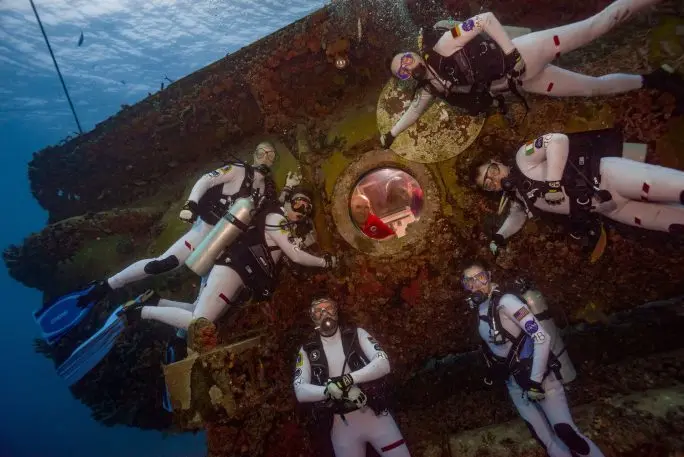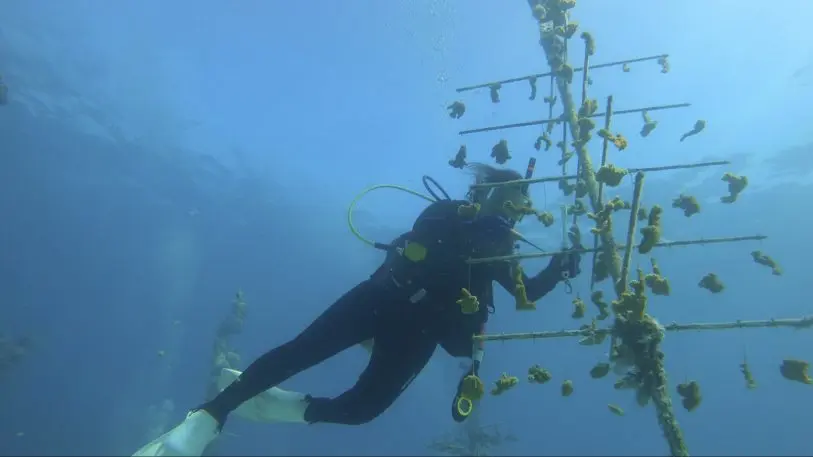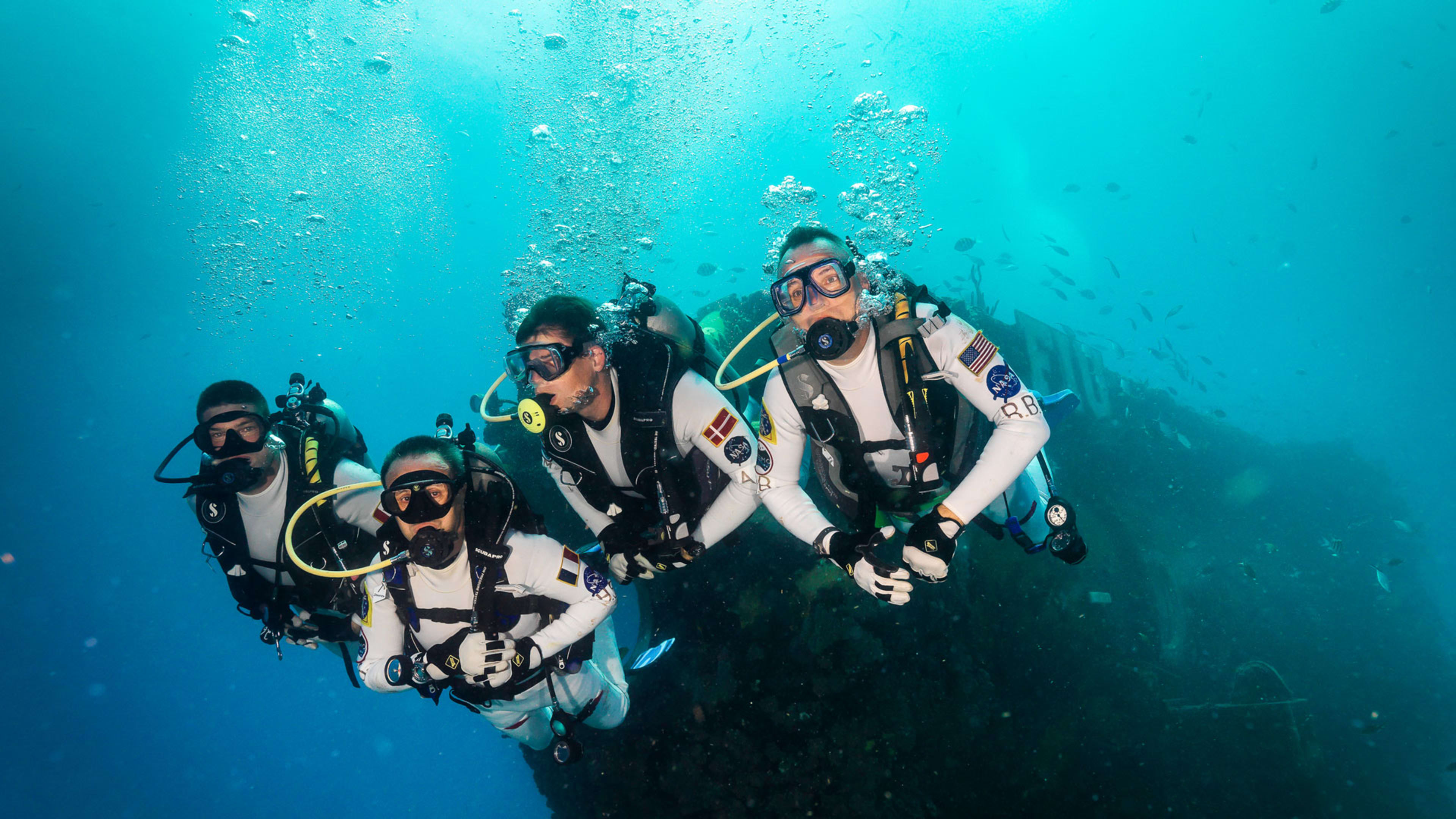There’s a poster in the Aquarius Reef Base command center in Islamorada, Florida, that chronicles the evolution from the first undersea habitat to the International Space Station (ISS). It usually merits no more than a glance from visitors. But Cady Coleman stops to peruse the text about Sealab, the experimental underwater habitats the Navy ran in the 1960s.
“My dad worked on Sealab,” says Coleman, slowly running her hand over its logo. “He was an engineer in charge of structural modifications. [Mercury astronaut] Scott Carpenter came over for dinner one night, as part of the team that was going to live under the sea. He had lunch with Jacques Cousteau. I grew up with the idea that exploration was normal: living someplace dangerous, where you really had to think about what you were doing. But I don’t think I grew up thinking I could be one of those explorers.”

The last underwater lab
Aquarius is the last working underwater laboratory in the world, of the more than 65 that have been built since 1957. Owned and operated by Florida International University in Miami, it’s stationed six miles off Key Largo in the Florida Keys National Marine Sanctuary. It includes a 1,400-cubic-foot camera- and sensor-equipped habitat and lab, a 500-cubic-foot entry lock, and a 700-cubic-foot “wet porch” and diver staging area perched on a sandy floor 60 feet underwater. The facility is connected to a 33-foot-diameter surface support buoy that supplies air, electricity, high-speed internet, and VOIP telephone service.
The reef base is used primarily for marine environment research, perfecting Navy diving technology and training divers. Since 2001, it’s also been home to NASA’s Extreme Environment Mission Operations (NEEMO) program. There, astronauts live and work underwater for up to three weeks at a time in live-streamed missions, encountering the same tasks and challenges they would in space as they troubleshoot obstacles in an extreme environment and compile data for current and future missions.

But Aquarius entrée is never guaranteed. November is the tail end of hurricane season. Two of the four planned DENT trips here were thwarted by weather conditions. This time, the weather is beautiful and the water a balmy 80 degrees, but a last-minute legal snag squelches our plans. So Broback quickly restructures the trip to a behind-the-scenes tour of the Aquarius ground operations and a dive with the nearby Coral Restoration Foundation, which enlists the public’s help in reef conservation and is affiliated with Aquarius.
The lab has a storied history, attracting oceanographic luminaries Sylvia Earle, Fabien Cousteau, and Robert Ballard, as well as activist/actors such as Ian Somerhalder of The Vampire Diaries and Entourage’s Adrian Grenier. It has persevered despite Mother Nature, ownership changes, and budget woes. Hurricanes have consistently wrought havoc, forcing its 1989 move from its original berth in St. Croix in the U.S. Virgin Islands and several subsequent shutdowns for repairs. The lab was originally owned by the National Oceanic and Atmospheric Administration (NOAA) and operated by the University of North Carolina-Wilmington; spending cuts threatened its closure until Florida International University (FIU) assumed operational control in 2012.
Now operating on a $1.5 million budget, down from just under $4.6 million at the height of its federal funding, Aquarius has recently been exploring new revenue streams. There’s some talk of opening it to larger marine education groups. And until the pandemic hit, it was building up its Aquarius Academy, a K-12 initiative that translates the science done at Aquarius into a state-sanctioned curriculum that includes bringing aquanauts to classrooms, and field trips for teachers and students to study the local ecosystem. In nearby counties, “some students are 20 miles from the ocean, and they don’t ever get there,” says Tom Potts, Aquarius’s associate director of research.
Thanks to the COVID-19 pandemic, the Aquarius has temporarily closed once again, with dive operations suspended except for major equipment failure. At the time of our visit, the habitat had only recently emerged from nearly two years of repairs after Hurricane Irma ravaged it in September 2017. It was reinstated last June with the 10-day NEEMO 23 mission. “We got our approval for human occupancy three days before the project was supposed to start,” says operations manager Roger Garcia, a retired Navy diver. “That’s how close it was.”
Touring mission control
For such a technical operation, the command center is remarkably unassuming, occupying the former site of a bait-and-tackle shop. Its only bling is a backlit wall-sized photo of an underwater reef and displays of vintage diving equipment. The first hint of engineering is the U-shaped mission control desk housing five surveillance monitors that serve as the eyes and ears on Aquarius. Garcia spends most of his time at this desk, coordinating a 6-to-10-person staff (depending on the mission) of boat operators and divers who maintain the exterior systems, along with habitat technicians managing the onboard life support and dive operations.

Garcia takes us out back, along the dock where two staff members are loading up a boat with maintenance equipment, and next door to an emergency decompression chamber, an iron tank the dimensions of a medium-sized truck. In the event of decompression sickness—a painful and potentially fatal condition caused by ascending too fast, in which nitrogen expands and bubbles into the bloodstream—the chamber takes the sufferer back to a higher pressure and slowly reduces the pressure on the body to more smoothly release the nitrogen.
“We’ve only had to use it twice in the history of the program,” says Garcia. “Hospitals in Islamorada and Miami have recompression chambers, but they don’t know our protocols. When you’re doing saturation diving, it’s a different ballgame than regular diving. The treatment is longer and more complex.”

Once decompression completes, technicians repressurize the habitat to match the outside water pressure at the habitat depth. That enables aquanauts to open an airlock into the wet porch, a room with a floor opening to the water. Keeping the wet porch air pressure equal to or greater than the water pressure at that depth stops the ocean water from flooding the chamber. There, aquanauts can don scuba gear, enter the water, and ascend to the surface in a no-decompression dive.
Life on a mission
NEEMO missions tackle challenges facing future space explorers, from the scientific to the psychological. Working underwater closely simulates working in zero gravity in a suit offering limited mobility, dexterity, vision, and orientation. What living underwater offers over conducting tasks in a pool is practice operating with a team in a dangerous environment and close quarters with no quick exit. Aquanauts learn underwater navigation so they don’t get lost and run out of air. Because their blood is saturated with nitrogen, they can’t immediately surface without risking death.
Retired astronaut Cady ColemanIt’s a good place to pick one or two aspects of future exploration and really dig in.”
Missions have replicated and evaluated scenarios for using science instruments and tools on the lunar surface, obtaining geological core samples, using augmented reality guides, and studying body composition, sleep, physiology, and psychology. Kopra’s crew provided scientific and engineering feedback for a new spacesuit design for working and walking on the moon. Coleman’s team explored telerobotic surgery, which had physicians remotely guiding them in procedures such as simulated gall bladder and appendix removal on an anatomical dummy.

With NASA’s renewed interest in returning to the moon, Garcia has noticed a shift in NEEMO’s mission focus, away from an earlier concentration on asteroid exploration. “We helped them put together a little work area that served as a rock wall,” he says. “The aquanaut would clip a harness to the wall and work as though they were on an asteroid. Now it’s more related to drilling, taking core samples, and looking at them under microscopes.”
Then there’s maintaining a challenging workflow amid a tight schedule in close quarters, where four scientists and two habitat technicians average 10-day missions. “How do you communicate succinctly and clearly when you have an operation?” says Kopra. “How do you deal with the stresses of living together and doing these kinds of functions?”
Aquanauts have little downtime. “We have a timeline where you’re scheduled every single minute,” says Coleman. “If you finish your task early, then you should look around and see who needs help. And if nobody needs help, then you should pick up a camera and take a picture or a video. And if you’re really still hanging around with nothing to do, which never happens, then you should sort the pictures and video you’ve taken and send it to the surface.”

Still, it’s a small price for the rarified experience of living and working alongside the marine life.
“You’re eating dinner, you’re doing work, you’re on a computer, and the food chain is right outside the window,” says Coleman. “There are certain fish that feel like the habitat is their home as well, and are always around the windows. I stayed up late almost every night and they would hang around until I went to bed and then swim off. So it was this neat combination of sharing their world. They realized that we were a part of their world for a reason, and I really loved that.”
“We have a big window next to the table where we ate. And this big grouper, about two feet in diameter and nine feet long, would put its eyeball next to our big window and look inside,” adds Kopra. “I remember going outside, seeing that big grouper, and wanting to get closer, but it was just a little bit too big for me.”
Restoring the reefs
After the Aquarius operations tour, our group moves onto the Coral Restoration Foundation (CRF), a 13-year-old conservation and educational initiative to restore Florida coastal reefs ravaged by storms and changing environmental conditions due to global warming and pollution. We join a one-day program that explains how its decline affects the marine ecosystem and enlists our help in nurturing and planting new coral.
Researchers there test different genotypes to see which thrive best and reproduce those. They grow new corals on “coral trees,” each comprising several horizontal pipes crisscrossing a vertical one. Developing juvenile corals (which are actually animal colonies) hang by strings to the “branches.” When the corals reach roughly half a foot, divers transplant them to surrounding reefs.
The classroom portion features a morning slideshow on the science, followed by training sessions on tree and reef models for our underwater work. After lunch, it’s a 30-minute boat ride with other divers to a staghorn coral nursery with dozens of coral trees roughly 30 feet underwater in a protected area. On the first dive, we spend some 45 minutes brushing off the algae covering the branches and strings, so it doesn’t overgrow and smother the corals. Fish immediately surround us as they grab for the broken bits of algae. The tricky part during this distraction is maintaining buoyancy so as not to accidentally kick or grasp the coral, potentially harming it.

Cady Coleman and Josh Simpson plant corals. [Video: Torian Richardson]“We’ve worked a lot with Aquarius base on their NEEMO missions,” says Alice Granger, CRF’s communications director. “In order to train astronauts for conditions they’re going to be facing in space or on other planets, they need tasks to give them a feel and understanding of what it’s like to work in different gravitation environments in spacesuits.”
Last year, CRF provided the NEEMO 23 aquanauts with coral trees and boulder corals to install during their mission. “It helps them with problem-solving and fine motor skills,” says Granger. “Researchers from FIU are monitoring their growth. It’s really useful for our work because this allows us to study how boulder corals grow at different depths, in different light environments, and different environments of fish.”
Like Aquarius, CRF is closed to the public during the pandemic and operating with a small crew, but it plans to reopen once the virus is under control. “We can’t do this alone. We need to be working with as many people as possible,” says Granger. “Buzz Aldrin visited a few years ago, and films like Chasing Coral really help galvanize and mobilize the public. As a result, we’ve had a lot more people get involved. Here we are showing that if we work together there is something we can do. We can turn this around and all is not lost.”
That connection between sea and space, cooperation between disciplines, and harnessing public engagement will serve to inspire future technologies and pioneers. Even our aspiring astronaut, Alyssa Carson, despite space camp experience, a pilot’s license, and advanced scuba certification, was still taken by the level of teamwork required at the Aquarius, and by extension in space. “And then hearing encouragement from Cady, of course, motivates me to continue pursuing my own dream,” she says.
“Some people think that space people are all about space, but space people are all about Earth as well,” adds Coleman. “It meant a lot to me to learn some of the facts behind coral and the loss of coral, but in a more hopeful way, what might be helping. I liked knowing I planted some things in the ocean and it might make a difference there.”
Recognize your brand’s excellence by applying to this year’s Brands That Matter Awards before the final deadline, June 7.
Sign up for Brands That Matter notifications here.
